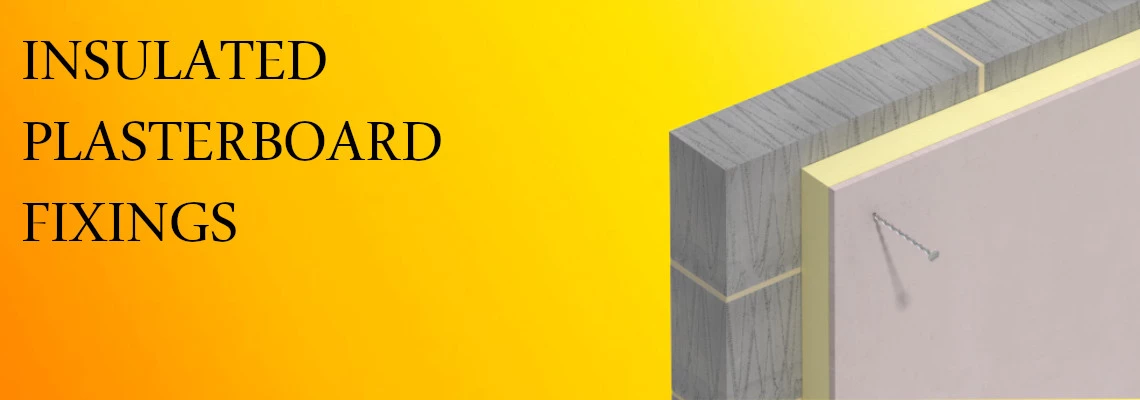
INSULATED PLASTERBOARD FIXINGS:THE ULTIMATE GUIDE*
Insulated plasterboard stands as one of the most ingenious solutions for efficiently insulating homes, especially when time and budget are of the essence. The installation of insulated plasterboard, however, has proven to be a headache for many UK builders and DIY enthusiasts. Successfully mounting insulated plasterboard demands strict adherence to specific techniques and the use of dedicated fixings. Deviating from these guidelines could result in unfortunate failures and eventual wall cracks, a situation everyone aims to avoid.
In this article, we will delve into the realm of pre-insulated plasterboard fixings, highlighting the best insulated plasterboard fixings, we will introduce several primary suppliers discussing associated costs, and examining fundamental fixings employed for solid and brick walls.
WHAT FIXINGS TO USE ON INSULATED PLASTERBOARD?
Insulated plasterboard fixings can be divided into two main categories: those used for mechanically fastening the insulated plasterboard to solid or brick walls, and those designed for attaching objects to their surface.
 When it comes to attaching materials to walls, one of the most commonly employed fixing options is the mechanical self-tapping helical nail (ISF18A).
When it comes to attaching materials to walls, one of the most commonly employed fixing options is the mechanical self-tapping helical nail (ISF18A).
This versatile fixing can be securely affixed to a diverse array of masonry and timber substrates.
Picture credit:ancon.co.uk
The second group of attachments serves for securing items onto thermal plasterboard, including various types of expansion plastic fixings like Uno by Rawlplug or Duopower by Fischer, as well as self-drive Panhead metal or Nylon fixings. String toggles are less commonly used as fixings for insulated plasterboard, as they require free space behind the surface of the plasterboard, which is not present in the insulated version.
BEST INSULATED PLASTERBOARD FIXINGS
Selecting the right fixings for insulated plasterboard is pivotal to ensure a seamless installation process and secure attachment of objects.
In this section, we delve into the top choices available, guiding you through the essential features and advantages of each type. Whether you're a seasoned builder or a DIY enthusiast, these superior fixings promise to streamline your projects and deliver remarkable results.
RAWLPLUG PLASTIC INSULATED PLASTERBOARD FIXINGS
 Plastic expansion wall plugs, commonly known as wall anchors, find their primary use in insulated plasterboard installations. Their design is specifically engineered to provide robust support within the soft gypsum core of the drywall.
Plastic expansion wall plugs, commonly known as wall anchors, find their primary use in insulated plasterboard installations. Their design is specifically engineered to provide robust support within the soft gypsum core of the drywall.
These fixings rely on a simple yet effective principle: expansion at the top upon insertion, resulting in an immediate and secure grip.
Their distinctive geometry ensures optimal expansion, further enhancing their holding power.
Picture credit:screwfix.com
ADVANTAGES:
relatively inexpensive, require basic tools like a screwdriver or a drill for their installation, immediate grip, slip prevention, colour coded
DISADVANTAGES:
precise diameter drilling required - otherwise they might rotate within the hole, limited weight, plastic product, 1 year warranty
PRICE:
£12.33(250PCS) inc VAT
INSTALLATION GUIDE

Picture credit:free-instruction-manuals.com
FISHER PLASTIC INSULATED PLASTERBOARD FIXINGS
FISHER UNIVERSAL DUOPOWER
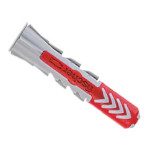 When it comes to attaching items to insulated plasterboard, Fisher stands out as another frequently relied upon brand. One prominent offering from Fisher is the Duopower fixing, a two-component material that excels in providing enhanced load capacities, particularly in hollow construction materials like thermal boards.
When it comes to attaching items to insulated plasterboard, Fisher stands out as another frequently relied upon brand. One prominent offering from Fisher is the Duopower fixing, a two-component material that excels in providing enhanced load capacities, particularly in hollow construction materials like thermal boards.
Picture credit:screwfix.com
Similar to its counterparts, this fixing also features a slim plug rim strategically engineered to prevent any unwelcome slippage within the drill hole. This meticulous design not only ensures precise positioning during installation but also simplifies the push-through process, rendering it seamless and efficient.
To further underscore its efficiency, the Duopower fixing incorporates a serrated profile that actively thwarts any possible plug rotation, upholding the desired orientation consistently. Moreover, the plug's shortened length has a dual benefit: it not only contributes to a reduction in drilling time but also significantly enhances the overall efficiency of the installation procedure.
Fisher's Duopower fixings, renowned for their reliability and innovation, contribute to making the attachment of items to insulated plasterboard a process marked by both ease and effectiveness.
ADVANTAGES: cheap product, made in germany, very adaptable, very reliable, held firm, high quality nylon, red expansion wings support the safe expansion and offer additional safety,
DISADVANTAGES: can hold light items, made of plastic
PRICE:
£7.49(100PCS) inc VAT
INSTALLATION GUIDE

Picture credit:docs.rs-online.com
FISHER PLASTERBOARD PLUG HDPF
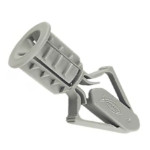 Produced from high-quality polyamide, making it very elastic and age-resistant. Their design pulls the plastic tails up tight behind the wall face making it very secure.
Produced from high-quality polyamide, making it very elastic and age-resistant. Their design pulls the plastic tails up tight behind the wall face making it very secure.
Small wings properly expand in isolation of the thermal plate, ensuring optimal grip in the material.
Picture credit:screwfix.com
ADVANTAGES: dedicated for plasterboard, general use fixing, easy to insert, very good value for money
DISADVANTAGES: not use them to hang anything too heavy, impossible to remove without damaging plasterboard, needs a squeeze in the middle to get it through the hole
PRICE:
£0.07(1no) inc VAT
INSTALLATION GUIDE

FISCHER SELF-DRILL METAL / PLASTIC PLASTERBOARD FIXINGS
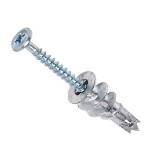 Convenient self-drilling anchor featuring a cross-drive design for effortless installation into insulated plasterboard. No need for a specialised tool for setting. The sharp, self-tapping thread ensures a strong and reliable attachment, offering substantial load-bearing capability. It accommodates screws ranging from 4 to 5mm in thickness, including wood, sheet metal, and chipboard screws, as well as various hooks and eye screws. Versatile application for securely and swiftly mounting lights, electrical fixtures, and a variety of accessories.
Convenient self-drilling anchor featuring a cross-drive design for effortless installation into insulated plasterboard. No need for a specialised tool for setting. The sharp, self-tapping thread ensures a strong and reliable attachment, offering substantial load-bearing capability. It accommodates screws ranging from 4 to 5mm in thickness, including wood, sheet metal, and chipboard screws, as well as various hooks and eye screws. Versatile application for securely and swiftly mounting lights, electrical fixtures, and a variety of accessories.
Picture credit:screwfix.com
ADVANTAGES: suitable for pre-positioned Installation, flat head
DISADVANTAGES: maximum weight for those fixings – 8 kg, leaves big hole ones removed
PRICE:
£0.011(1no) inc VAT
INSTALLATION GUIDE

Picture credit:rawlplug.co.uk
INSOFAST HELICAL NAIL INSULATED PLASTERBOARD FIXING
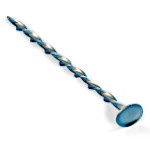 These metal fasteners have a self-tapping helical shank equipped with work-hardened blades, enabling them to cut into various masonry and timber substrates when used with an adapter powered by a standard SDS hammer drill.
These metal fasteners have a self-tapping helical shank equipped with work-hardened blades, enabling them to cut into various masonry and timber substrates when used with an adapter powered by a standard SDS hammer drill.
Picture credit:amazon.co.uk
The unique dished head of these insulated plasterboard fixings effectively compresses the gyproc layer without damaging the paper surface. This creates a deep recess perfect for holding filler material securely. These fixings offer flexibility by working with 'dot and dab' adhesive (3 fixings per board) or can replace it entirely (12 fixings per board).
With the SDS adapter, Insofast insulated plasterboard fixings can be swiftly driven using a hammer, reducing labour costs for upgrading internal solid wall insulation. Cold bridging concerns are minimised thanks to a thermally efficient spiral shaft that is just 25% the cross-sectional area of an equivalent solid shaft. The fully countersunk head indents into the insulated plasterboard without tearing it.
They're suitable for direct installation into aircrete blocks and softwood timber. Designed for securing foam insulated plasterboards like Celotex PL4000, Xtratherm (Unilin) XT/TL or Kingspan K118.
They are available in lengths: 65mm, 85mm, 105mm, 125mm and 145mm. Their typical pull-through strengths is 340N for 12.5mm Plasterboard bonded to PIR core and 255N for 9.5mm Plasterboard.
ADVANTAGES: fast installation, fire-proof
DISADVANTAGES: requires sds drill bit, power tools involved
PRICE: £22.63 (20PCS)
INSTALLATION GUIDE

BLACK OXIDE SCREWS FIXINGS FOR INSULATED PLASTERBOARD
 For attaching thermal boards, in specific cases, black oxide screws can be used. This is feasible only when securing to brick blocks, which are materials with considerably lower density. The sharp edges of the screw deeply penetrate the blocks, ensuring proper grip of the insulated plasterboard. It is recommended to install a minimum of 15 screws per 8x4 board.
For attaching thermal boards, in specific cases, black oxide screws can be used. This is feasible only when securing to brick blocks, which are materials with considerably lower density. The sharp edges of the screw deeply penetrate the blocks, ensuring proper grip of the insulated plasterboard. It is recommended to install a minimum of 15 screws per 8x4 board.
When installing the board onto a pre-constructed timber stud wall, black screws become indispensable for directly securing insulated plasterboard panels. In these instances, the depth of screw penetration should not be less than 40mm-50mm.
ADVANTAGES: speed of installation, price, flat head
DISADVANTAGES: sharp edges of screw, easy to break
PRICE: £0.02(1no)
In summary, the most commonly utilized fixings for attaching insulated plasterboard to walls are the helical nails. For securing items onto insulated plasterboard, red or blue plastic plugs like Uno from Rawlplug are frequently employed.
CAN YOU FIX INSULATED PLASTERBOARD DIRECTLY TO WALL? / HOW DO YOU SECURE INSULATED PLASTERBOARD?
Physically screwing insulated plasterboard directly onto the wall with 12 fixings on an 8x4 panel is technically possible, but it's not recommended due to limited space for ventilation. That's why the "Dot and Dab" method is more commonly used, where the board is initially glued to the wall. After the adhesive dries, the board is then further secured, usually with 3 fixings across the entire size of the board, as an additional precaution.
CAN YOU SCREW INTO INSULATED PLASTERBOARD?
Insulated plasterboard is essentially a gypsum board securely adhered to insulation material. The insulation itself, usually in foam form, lacks load-bearing properties as it's too soft. On the other hand, plasterboard consists of tightly compressed gypsum and attempting to screw directly into it will likely not hold even under minimal load.
Therefore, it's not recommended to use regular screws directly into insulated plasterboard. Instead, specially designed insulated plasterboard fixings are employed for this purpose. These fixings are typically anchored on the rear surface of the gypsum board to ensure proper stability and load-bearing capability.
INSULATED PLASTERBOARD FIXINGS SCREWFIX / WICKES / TOOLSTATION
All sorts of fixings, whether for concrete or brick wall surfaces, are typically associated with and purchased from well-known stores like Screwfix, Wickes, or Toolstation. These stores are familiar to construction professionals and offer trade discounts. You can find a wide variety of fixings for insulated plasterboard there. Depending on the loads they need to bear, it's crucial to select the appropriate type of fastening. Often-recognized brands in this field include Rawlplug, Fischer, and Insofast.
INSULATED PLASTERBOARD FIXINGS COST
The prices of plastic insulated plasterboard fixings don't differ significantly. A rawlplug expansion plug, for instance, costs around £0.05 each, while a single Fischer fixing could require spending around £0.07. Considering the amount of work they save us, these costs are relatively minor. The prices of fixings for insulated plasterboard increase proportionally with the materials they're made from.
For instance, metal self-drive fixings cost £0.11, almost twice as much as the rawlplug plugs for comparison. However, these are made from metal or reinforced plastic. On the other hand, the most expensive fixings for directly attaching insulated plasterboard to a solid wall are the Insofast 18A fixings, priced at £1.13 each. Nevertheless, these fixings are Corrosion-Resistant.
FIXINGS FOR 50MM INSULATED PLASTERBOARD
Due to building regulations, a U-value of 0.28 is required for walls. The minimum thickness that achieves this is 50mm. Hence, 50mm is the most commonly chosen thickness for insulated plasterboard. To physically attach this thickness, INSOFAST 18A nails are frequently used. These nails are 105mm long, at least 50mm longer than the actual board thickness.
FIXING INSULATED PLASTERBOARD TO SOLID WALLS / BRICK WALLS
The most common scenario we encounter in homes in the UK is the necessity of attaching insulated plasterboard panels to solid walls or brick walls. So, let's explain how to do it best
For brick, concrete block, and hardwood, it's advised to create a 5mm pilot hole. When dealing with structural concrete and engineered brick, a 6mm pilot hole is necessary. In some cases, longer fixings might be needed to ensure proper embedding in the underlying structure.
To install insulated plasterboard fixings, you can either use a rubber mallet to gently hammer them into the pilot holes or use an appropriate SDS adapter with a lightweight SDS drill. The drill should be set to a slow speed, and the rotary action should be disengaged.
Suggested depths for secure attachment within different substrates are as follows:
- For aircrete, aim for an embedment of 50-75mm.
- When dealing with brick or block, a depth of 40-60mm is advised.
- For softwood, ensure an embedment of 35-50mm for reliable fixation.
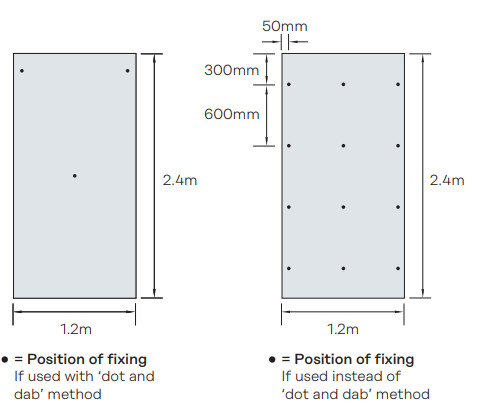
Picture credit:ancon.co.uk
CONCLUSION
Summing up, attaching insulation-core panels isn't challenging; it merely involves using suitable fixings to ensure their secure adherence to the walls. Proper embedding of fixings into solid walls is crucial, with a minimum depth of at least 40mm into the wall. Among the preferred choices are INSOFAST 18A fixings, which are designed to facilitate insulated plasterboard installation with their SDS drill bit compatibility.
For mounting objects on insulated plasterboard, similar techniques to those used for regular plasterboard apply. However, remember that insulated plasterboard lacks a cavity between the insulation and the gypsum layer, making the use of winged fixings not recommended due to their expansion mechanism being unfeasible.
The most optimal choices are UNO plugs from Rawlplug or metal self-drive fixings.
Related articles:
HOW TO INSTALL INSULATED PLASTERBOARD?
A COMPREHENSIVE GUIDE TO INSULATED PLASTERBOARD FOR CEILING INSULATION
MANAGING MOISTURE: DO YOU NEED A VAPOUR BARRIER WITH INSULATED PLASTERBOARD?
INSULATION BACKED PLASTERBOARD THICKNESS
*All the information provided in the content published on Insulationgo blog is for informational and educational purposes only. Insulationgo LTD makes every effort to ensure the accuracy and timeliness of the content, but we do not assume any responsibility for any errors or omissions.
The information presented on this blog should not be considered as professional advice or a substitute for consulting relevant experts. Before making any purchase decisions or taking action based on the information presented here, it is strongly recommended to contact the product manufacturer directly to verify the details and ensure its suitability for your specific needs.
By using this blog, you acknowledge and agree that Insulationgo LTD shall not be held liable for any damages, losses, or inconveniences arising from the use or reliance on the information provided herein. This limitation of liability applies to all users of the blog, including but not limited to visitors, readers, and subscribers.










































































































